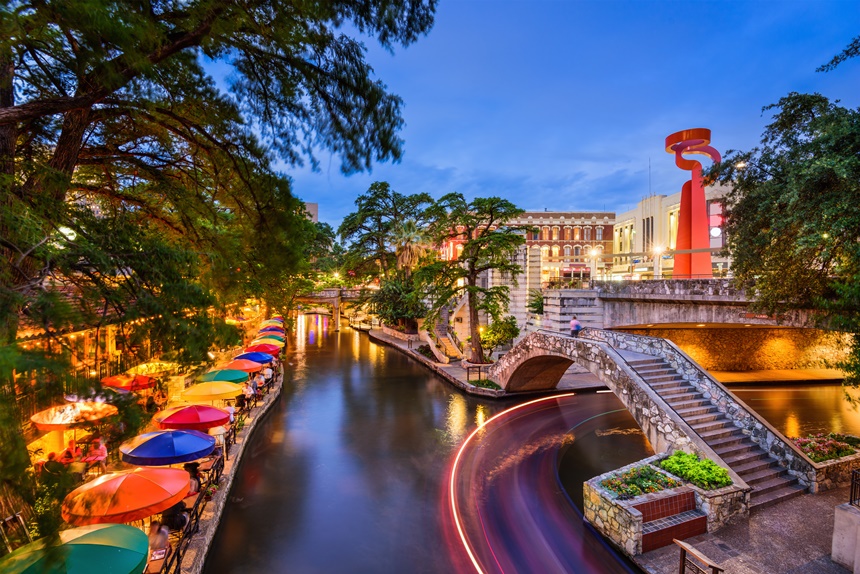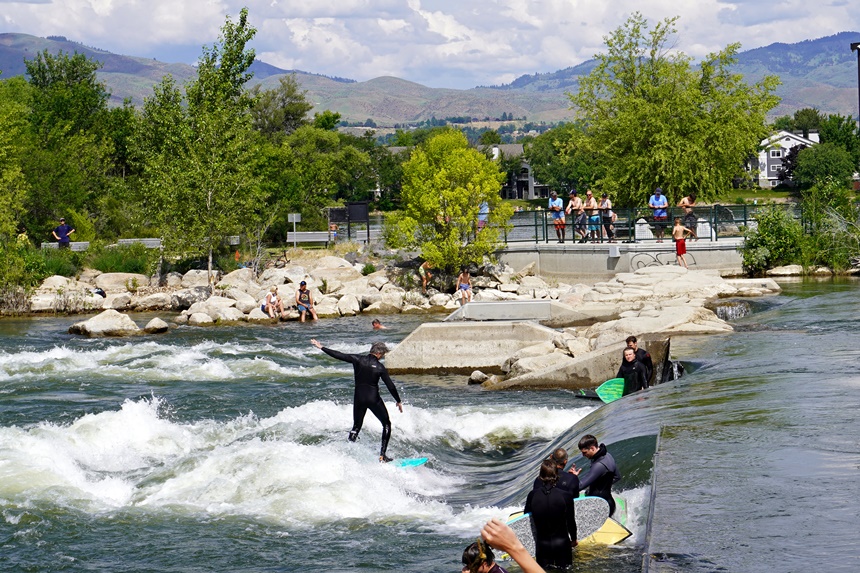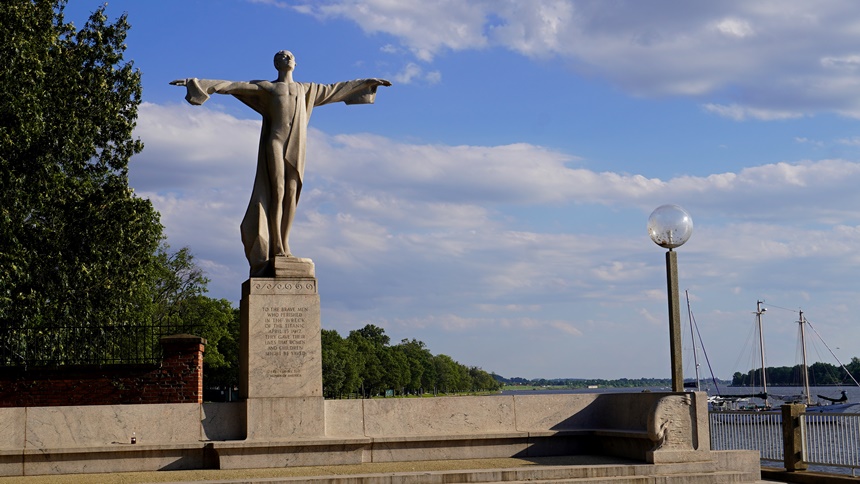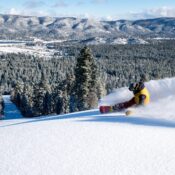The folks in South Texas are proud of the San Antonio River Walk, and rightly so. Curling through the city’s downtown, plied by festive tour boats and lined with fancy restaurants, it’s a one-of-a-kind urban experience.

But there are lots of rivers in the U.S., with lots of towns on them. And a hopscotch around the country reveals there’s no shortage of other equally charming — and often spectacular — river walks.
Boise River Greenbelt
Boise, Idaho
cityofboise.org/departments/parks-and-recreation/parks/boise-greenbelt/

“Have you been watching the surfing competition?” asks the young woman pouring me a lovely cab at Telaya Wine Co., a contemporary winery that’s been sitting on the bank of the Boise River since 2016.
I look around the wood-paneled tasting room for a TV screen, figuring ESPN would be the only way Idahoans could possibly witness surfing. My host immediately realizes my cluelessness.
“Out on the river,” she says, raising her eyes to the window behind me and the river beyond. “When you leave here, go out to the river walk and turn left. A hundred yards or so up the walk. You can’t miss it.”
A flight of cabernets, grenaches, and verdejos later, I’m weaving my way past the Telaya’s outdoor wine garden, fire pit and high-top tables, heading out to the local stretch of the Boise River Greenbelt, an 18-mile trail loop that traces both banks from here, in Garden City, to Boise, just a couple of miles to the southeast.
As I walk downstream, the air is filled with the sounds of bicycle bells and laughing kids running ahead of their parents. Next comes the rumble of rushing water, and then, there they are: A dozen or so men and women in wet suits, most of them floating on surf boards, a couple of them standing, catching the crest of a perpetual wave pouring over a low dam.
The place even has its own surf shop: About 100 yards from here, Corridor Surf owner Victor Myers has been handcrafting boards for locals and visitors alike for years.
There’s no shortage of river walks that provide interesting cityscape views or that, like this one, pass from an urban area to a wide-open landscape and back. But in my experience, only one offers the somewhat surreal experience of watching surfers hang ten some 400 miles from the nearest ocean.
D.C. Waterfront/Anacostia Riverwalk Trail
Washington, D.C.
capitolriverfront.org/go/anacostia-riverwalk-trail

A decade or so ago, anyone venturing along Washington, D.C.’s waterfront after dark was either looking for trouble or planning to make some. Dark, deserted, and lined with abandoned industrial buildings, the waterfront was almost comically catastrophic; operatically awful.
But there’s been a miracle on the waterfront, one that has rendered the place absolutely unrecognizable from its sordid past. Glass residences rise from a broad, brightly lit walkway lined with open-air restaurants, barista bars, and snack stands. Water taxis chug up to the docks on the once fetid, now-glistening channel. And on any given weekend, a parade of families and tourists stream to and fro, stopping to watch dance performances or splash in wading pools that double as public art.
In fact, were you to try and partake of all the sights and activities along the three-mile river walk between Benjamin Banneker Park, on the Washington boat channel, to the Anacostia River’s 11th Street Bridge, that stroll would most likely require a day or two. And that’s not including taking in a baseball game at Nationals Park, a soccer match at Audi Field, or the National Museum of the United States Navy in the old Washington Navy Yard.
Still, I have one favorite spot along this bustling pedestrian thoroughfare that I visit whenever I get a chance, a quiet oasis where the path abruptly makes a turn inland to bypass Fort McNair (where, it is worth noting, the Lincoln assassination conspirators were hanged).
At this juncture stands a 13-foot-tall granite statue, his arms outstretched, his face raised with a peaceful expression. “To the Brave Men Who Perished in The Titanic,” the inscription reads. “They Gave Their Lives That Women and Children Might Be Saved.”

Paid for by donations from women nationwide, the sculpture was, fittingly, created by a woman: sculptor Gertrude Vanderbilt Whitney, and yes, she was one of those Vanderbilts. The base was one of the last commissions by Henry Bacon, who designed the Lincoln Memorial.
Gazing up at the imposing figure, the tableau seems strangely familiar to me. Like in some obscure movie about the Titanic. I seem to remember a guy posed just like this, standing on the ship’s bow, yelling, “I’m king of the world!”
Art, it appears, imitates art, which imitates life.
Fox River Bike Trail
Green Bay, Wisconsin
dnr.wisconsin.gov/topic/parks/foxriver

There’s a tendency among most people to think rivers flow south, so as you head downstream on the Fox River State Trail, you have to keep reminding yourself you’re heading north, toward Green Bay.
Kayakers and weekend boaters speed past as you follow the former railroad bed, which in turn was built upon centuries-old Native American footpaths. The trail hugs the river right through Green Bay, but you may want to linger just south of the city, in the charming little downtown of De Pere.
A few blocks off the trail, listen for the music coming from Cycling Brews (which, despite the name, does brisk business serving local beers to thirsty trail walkers). Or if it’s a bit later in the day, experience the longtime tradition of Wisconsin dinner clubs at the circa 1880s Union Hotel, stopping for a pre-dinner drink in the lavish bar and settling in for a too-big-for-one-person steak (ask owner Jim Boyd, whose family has owned the place since 1918, to tell you the Union’s ghost story).
Just north of De Pere, take a small detour to visit Voyageur Park, where, if you’re lucky, you’ll witness a pleasure boat passing through one of the few surviving hand-cranked river locks in the U.S.
Hudson River Waterfront Walkway
Fort Lee-Hoboken-Jersey City, NJ
hudsonriverwaterfront.org

New Yorkers like to brag about the bike trail that traces the Hudson River’s Manhattan bank from the George Washington Bridge to the Battery. But for views of the city’s ever-more-spectacular skyline, you can’t beat this 23-mile path that starts north of the bridge and currently runs, almost uninterrupted, to Liberty State Park, within sight of the Lady in the Harbor (plans are afoot to continue the walk all the way to the Bayonne Bridge).
The sheer contrast in landscapes is breathtaking: At the north end, the 200-foot-high Palisades — sheer cliffs of basalt rock — rise from the water’s edge. So dramatic is the sight of those cliffs that the appearance of the GW Bridge, its west tower standing just feet off shore, can come as a surprise.
Few people make the entire walk in a day, but it’s easy to find stop-off points, especially when you arrive at the area of the Lincoln Tunnel at Weehawken. After you reach the Liberty State Park terminus, hop on over to the recently completed length in Bayonne, where the river melts into marshland and the Bayonne Golf Club — built on a mountain of silt dredged to deepen the nearby ports — is graced with a clubhouse that resembles a New England lighthouse.
East Bank Trail
South Bend, Indiana
traillink.com/trail/east-bank-trail-(in)

The trail that hugs the eastern bank of the St. Joseph River provides a welcome green ribbon between the water and the businesses of South Bend. Occasionally, it opens up to vast green spaces like Howard Park, with its 13,000-square-foot state-of-the-art playground and, in winter, a one-a-kind ice skating trail that offers beginners and skate pros alike a gentle course of rolling hills and soft curves.
Strolling along the downtown portion of the trail one summer day, I was startled to see a group of yellow-helmeted people carrying a rubber whitewater raft. Naturally, I followed this curious crew and watched, somewhat mystified, as they carried that raft down a ramp and set it down in a narrow channel of rushing water. Off they went down the narrow course, whooping as they surged over waterfalls, maneuvered between rocky barriers, and took on water from geysering sprays.
Naturally, I want to join them, and I’m glad to say I did. And so can you: The East Race Waterway, the oldest urban white water rafting facility in the country, was created nearly 40 years ago when this century-old, concrete-lined channel — originally excavated to power South Bend factories — was cleaned up and repurposed by a group of enterprising local businesspeople.
Now, for $6 ($20 for unlimited daily rides), anyone can wander down the river walk and be transported to a whitewater maelstrom that’s 2,000 feet long with a drop of about 12 feet.
Truckee River Walk
Reno, Nevada
travelnevada.com/cultural-activities/downtown-reno-riverwalk/

The time to set out on Reno’s downtown river walk — a stretch of about 15 blocks overlooking the leaping waters of the Sierra-fed Truckee River — is at dusk; after the heat of the high desert day but before the mountain air takes on its evening chill.
With the sun slipping behind the distant peaks, start at Wingfield Park, a lush island set like a long, green sailing ship in the river. Five bridges lead to the island, and if you’re lucky there’ll be music playing at the amphitheater. In any case, don’t miss the nightly show of kids and adults down on the rocky beach, wading in the rushing water and catching the last glint of sunlight.
Depending on how you count them, seven or eight bridges span the Truckee along the trail, which offers you the option of walking on either bank. Take the time to explore all the possibilities, or else you might miss The Space Whale, an enormous sculpture of a whale mother and her calf, both lit from inside from dusk on.
For dinner, settle in at one of the many open-air restaurants that sit on the Truckee’s banks. The Wild River Grille offers a killer plum chipotle salmon and a seafood truffle risotto that could make you swear off mom’s cooking. But whatever you order, do not miss the Grille’s signature dessert: Truckee River Mud, consisting of a Klondike bar atop a warm brownie drizzled with caramel and chocolate sauce and topped with fresh whipped cream.
Then head back out onto the river walk, just to burn off as many of those calories as possible.
Become a Saturday Evening Post member and enjoy unlimited access. Subscribe now




Comments
There are several enticing river walks here, and I appreciate the pictures and details. Still, if I could only pick one, it would have to be the San Antonio River Walk. It has a Far East essence to it I love, that could be straight out of Japan or today’s beautiful Vietnam.
You didn’t mention the Providence, Rhode Island Riverwalk which is not only scenic and relaxing, it’s also the site of Waterfire – a beautiful instillation of wood fire braziers along the river that are set ablaze on certain nights along with atmospheric music.